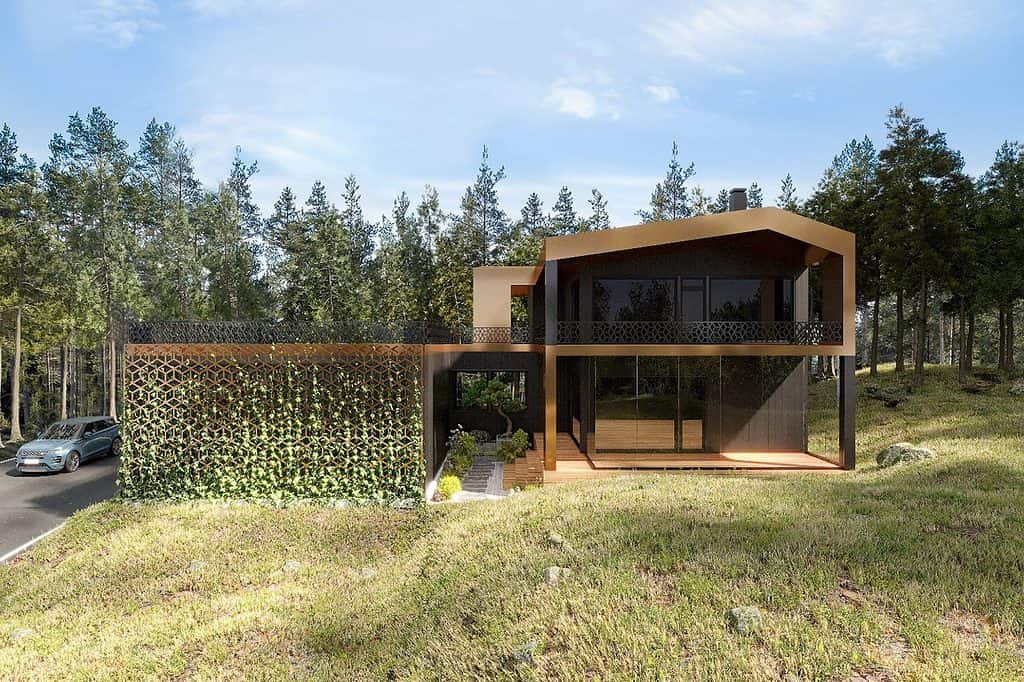Single-material wooden house Villa Pinta aims for energy class A
Villa Pinta is a carbon-efficient, real wooden house built on-site, whose energy efficiency is guaranteed by the blowing installation of dense Termex Cellulose insulation.
A professional in striking interior surfaces who has become known as an apartment flipper, Kati Jensen is building her new detached house at the Naantali Asuntomessut house exhibition. Item number 13, Villa Pinta, is particularly energy efficient, as its calculated energy consumption value is 77. Only 12,612 kWh of purchased energy is calculated per year for heating the premises and domestic water, electrical equipment, and cooling. Villa Pinta aims for the A energy class according to the 2018 energy certificate regulation.
For Kati Jensen, ecology and energy efficiency are important values in themselves. As the price of energy rises rapidly, the most important thing in construction right now, in Kati Jensen’s opinion, is to focus on increasing energy efficiency.
Kati Jensen chose the most energy-efficient windows, doors and structural solutions for her house. The house and its domestic water are heated by an air-water heat pump, and the annual efficiency of ventilation heat recovery is 76 per cent.
Breathable, safe construction
Villa Pinta is an authentic wooden house built on the spot. – The single-material wood structure is moisture-proof. The breathable structure equalises moisture and reduces the moisture load on the wood, says Kati Jensen. – As climate change progresses, this is even more important than before.
Villa Pinta’s single-material wood fibre structure is insulated with machine-blown Termex Cellulose insulation.
The fire- and moisture-proof Termex Cellulose insulation, made by defibrating ecologically sorted recycled paper in Finland, has a high specific heat capacity, meaning a high resistance to temperature changes. This property evens out sudden fluctuations in room temperature in relation to the outdoor temperature. The insulation material’s excellent thermal insulation properties are based on the seamlessness of the insulation, the breathability of the porous wood fibre, and its low air permeability.
Humidity affects the quality of room air. The breathable structure evens out the humidity fluctuations in the indoor air, keeping the humidity at a comfortable level.
In the case of a fire, Termex Cellulose retains its volume without melting, even at high temperatures, and it burns by slowly smouldering. The wood-framed Termex insulated wall meets the strict REI 30 and REI 60 classes. The European fire class of Termex Cellulose is B-s2,d0 (extremely low effect on fire).
Fully sealed insulation quickly
Termex was installed in Villa Pinna’s structures by blowing. – Insulating fibre installed by blowing fills all holes and gaps. The end result is settlement-free and seamless. Kati Jensen says there are no thermal bridges in the structure, and point-like leaks will not form later, either.
It is very difficult to get the same kind of dense structure with insulation boards – especially not as quickly. Kati Jensen started her exhibition house project at a disadvantage after applying for a plot for which the reservation was cancelled, so there was no room for delays in the construction.
– We had to choose construction methods that would allow us to catch up with the others and stay on schedule. The blowing of Termex started on schedule and lasted for as long as predicted.
The airtightness of Villa Pinna’s structures is brought about using the Finnish company Eltete Oy’s laminated diffusion-open Termex Kraft air barrier paper. – Termex Kraft is made of wood, similarly to the structure of the building and the cellulose insulation. The single material guarantees good moisture function, good indoor air and a long-lasting structure, says Eltete Oy’s sales manager Anton Österman.
Ecological insulation with a carbon handprint
– Termex is a pioneer in ecological insulation. Termex Cellulose insulation, made from wood-based recycled fibre, actually has a carbon handprint, Termex-Eriste Oy’s CEO Markus Rautiainen highlights.
The carbon footprint of the cellulose insulation is extremely small. Its total carbon balance in a life-cycle analysis can even be negative, as it stores more than ten times more carbon dioxide during the life cycle of a building than is emitted in its production.
Wind power certified by the Finnish Association for Nature Conservation and meeting the international EKOenergy criteria is used in the production of Termex.

